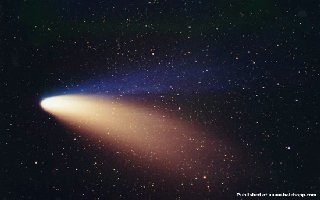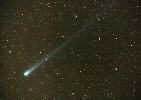
Comets

Comets
| Nucleus: | relatively solid and stable, mostly ice and gas with a small amount of dust and other solids; |
| Coma: | dense cloud of water, carbon dioxide and other neutral gases sublimed off of the nucleus; |
| Hydrogen Cloud: | huge (millions of km in diameter) but very sparse envelope of neutral hydrogen; |
| Dust Tail: | up to 10 million km long composed of smoke-sized dust particles driven off the nucleus by escaping gases; this is the most prominent part of a comet to the naked eye; |
| Ion Tail: | up to 100 million km long composed of plasma and laced with rays and streamers caused by interactions with the solar wind. |
Comets are invisible except when they are near the Sun. Most comets have highly eccentric orbits which take them far beyond the orbit of Pluto; these are seen once and then disappear for millennia. Only the short and intermediate period comets like Comet Halley, stay within the orbit of Pluto for a significant fraction of their orbits. Repeated passes near the Sun boils off most of a comet's ice and gas leaving a rocky object very much like an asteroid in appearance. A comet whose orbit takes it near the Sun is also likely to either impact one of the planets or to be ejected out of the solar system by a close encounter with a planet; especially with Jupiter.
By far the most famous comet is Comet Halley but Shoemaker Levy 9 was a big hit for a week in the summer of 1994. Meteor showers sometimes occur when the Earth passes through the orbit of a comet. Some occur with great regularity: the Perseid meteor shower occurs every year between August 9 and 13 when the Earth passes through the orbit of Comet Swift-Tuttle. Comet Halley is the source of the Orionid shower in October. Many comets are first discovered by amateur astronomers.
 As comets approach the Sun they develop enormous tails of luminous material that extend for millions of kilometers from the head, away from the Sun. When far from the Sun, the nucleus is very cold and its material is frozen solid within the nucleus. In this state comets are sometimes referred to as a "dirty iceberg" or "dirty snowball," since about half of their material is ice. When a comet approaches within a few Astronomical Units (1 AU equals approximately 150 million kilometers) of the Sun, the surface of the nucleus begins to warm, and volatile material on the comet evaporates. The evaporating gases carry small grains with them, forming the comet's coma of gas and dust.
As comets approach the Sun they develop enormous tails of luminous material that extend for millions of kilometers from the head, away from the Sun. When far from the Sun, the nucleus is very cold and its material is frozen solid within the nucleus. In this state comets are sometimes referred to as a "dirty iceberg" or "dirty snowball," since about half of their material is ice. When a comet approaches within a few Astronomical Units (1 AU equals approximately 150 million kilometers) of the Sun, the surface of the nucleus begins to warm, and volatile material on the comet evaporates. The evaporating gases carry small grains with them, forming the comet's coma of gas and dust.
When the nucleus is frozen, it can be seen only by reflected sunlight. However, when a coma develops, dust reflects still more sunlight, and gas in the coma absorbs ultraviolet radiation and begins to fluoresce.
A comet nucleus is small, so its gravitational pull is very weak. You could run and jump completely off of it (if you could get traction). The escape velocity is only about 1 meter (3 feet) per second (compared to 11 km/s--7 miles/second--on Earth). As a result, the escaping gases and the small solid particles (dust) that they drag with them never fall back to the nucleus surface. Radiation pressure, the pressure of sunlight, forces the dust particles back into a dust tail in the direction opposite to the Sun. A comet's tail can be tens of millions of kilometers in length when seen in the reflected sunlight. The gas molecules are torn apart by solar ultraviolet light, often losing electrons and becoming electrically charged fragments or ions. The ions interact with the wind of charged particles flowing out from the Sun and are forced back into an ion tail, which again can extend for millions of kilometers in the direction opposite to the Sun. These ions can be seen as they fluoresce in sunlight.
Every comet then really has two tails, a dust tail and an ion tail. If the comet is faint, only one or neither tail may be detectable, and the comet may appear just as a fuzzy blob of light, even in a big telescope.
 The density of material in the coma and tails is very low, lower than the best vacuum that can be produced in most laboratories. In 1986, the Giotto spacecraft flew right through Comet Halley only a few hundred kilometers from the nucleus. Though the coma and tails of a comet may extend for tens of millions of kilometers and become easily visible to the naked eye in Earth's night sky, as Comet West's were in 1976, the entire phenomenon is the product of a tiny nucleus only a few kilometers across.
The density of material in the coma and tails is very low, lower than the best vacuum that can be produced in most laboratories. In 1986, the Giotto spacecraft flew right through Comet Halley only a few hundred kilometers from the nucleus. Though the coma and tails of a comet may extend for tens of millions of kilometers and become easily visible to the naked eye in Earth's night sky, as Comet West's were in 1976, the entire phenomenon is the product of a tiny nucleus only a few kilometers across.
Because comet nuclei are so small, they are quite difficult to study from Earth. They always appear at most as a point of light in even the largest telescope, if not lost completely in the glare of the coma. A great deal was learned when the European Space Agency, the Soviet Union, and the Japanese sent spacecraft to fly by Comet Halley in 1986. For the first time, actual images of an active nucleus were obtained and the composition of the dust and gases flowing from it was directly measured. Early in the next century, the Europeans plan to send a spacecraft called Rosetta to rendezvous with a comet and watch it closely for a long period of time. Even this sophisticated mission is not likely to tell scientists a great deal about the interior structure of comets, however. Therefore, the opportunity to reconstruct the events that occurred when Shoemaker-Levy 9 split and to study what occurred when fragments were destroyed in Jupiter's atmosphere is uniquely important.
| Our solar system began as a vast cloud of gas and dust. Several billion years ago, this cloud slowly rotated around our very young sun and particles within the cloud collided with one another. During this time some objects were obliterated by these collisions, while others grew in size and were to later become the planets. Throughout this early period, comets probably filled the solar system. Their collisions with the early planets played a major part in the growth and evolution of each planet. The ices that make up comets appear to have been the very building blocks that formed the early atmospheres of the planets, and scientists now very strongly believe that it was the collisions of comets that brought water to our world and enabled life to begin. Over the years, comets actually became rarer within our solar system. They no longer fill the skies as they did 4 billion years ago, and today a prominent naked-eye comet can be expected only about once a decade. Astronomers with powerful telescopes can see many more comets, but even in this case it is still rare for as many as 15 or 20 comets to be detectable in the sky at any one time.
The Oort Cloud was first theorized by the Dutch astronomer Jan Oort in 1950. His investigation of the orbits of comets with very long orbital periods brought him to conclude that a large "cloud" of comets existed far outside the solar system, possibly within the range of 5-8 trillion kilometers (or more) from the sun. The total number of comets within this belt was estimated as a trillion. It is thought that objects within this cloud are occasionally ejected either by collision with one another, or by the gravitational forces of stars. Many of the ejected objects probably never cross the paths of the planets, and still more do not come close enough to be seen with even the largest telescopes. However, a few do manage to travel into the inner solar system and are subsequently seen from Earth. This cloud remains a theory only, as it has never been directly detected. The Kuiper Belt is a region first theorized by the Dutch-American astronomer Gerard Kuiper in 1951. Seeing that Oort's cloud of comets did not adequately account for the population of comets with short orbital periods (making complete orbits around the sun in less than 200 years), Kuiper conjectured that a belt of comets probably existed outside the orbit of Neptune within the range of 30 to 50 astronomical units (2.8 to 4.6 billion miles) from the sun. Collisions and perturbations by the planets of our solar system are believed to be the reasons for the ejection of bodies from this belt. Around 1988, astronomers David Jewitt (University of Hawaii) and Jane Luu (University of California at Berkeley) began searching for members of the Kuiper belt using modern electronic cameras attached to a large telescope on Mauna Kea, Hawaii. The equipment was capable of detecting extremely faint objects. After nearly 5 years of systematic searching they found a distinct image on 1992 August 30, which was subsequently designated 1992 QB1. The object was moving very slowly, and calculations eventually revealed the object took 291 years to orbit the sun at an average distance of 43 AU. Since, the discovery of that object over three dozen additional objects had been found as of the end of 1996. |
|
| LinkExchange Member | Free Home Pages at GeoCities |